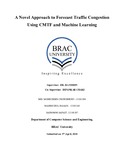| dc.contributor.advisor | Uddin, Jia | |
| dc.contributor.advisor | Chaki, Dipankar | |
| dc.contributor.author | Chowdhury, Md. Mohiuddin | |
| dc.contributor.author | Hasan, Mahmudul | |
| dc.contributor.author | Safait, Saimoom | |
| dc.date.accessioned | 2018-05-10T10:07:34Z | |
| dc.date.available | 2018-05-10T10:07:34Z | |
| dc.date.copyright | 2018 | |
| dc.date.issued | 2018-04 | |
| dc.identifier.other | ID 13101198 | |
| dc.identifier.other | ID 13101165 | |
| dc.identifier.other | ID 13101197 | |
| dc.identifier.uri | http://hdl.handle.net/10361/10121 | |
| dc.description | This thesis is submitted in partial fulfilment of the requirements for the degree of Bachelor of Science in Computer Science and Engineering, 2018. | en_US |
| dc.description | Cataloged from PDF version of thesis. | |
| dc.description | Includes bibliographical references (pages 30-31). | |
| dc.description.abstract | Traffic congestion severely affects many cities around the world causing various problems
like fuel wastage, increased stress levels, delayed deliveries and monetary losses. Therefore, it is
urgent to make an accurate prediction of traffic jams to minimize these losses. But forecasting is a
real challenge to obtain promising results for vibrant and ambiguous traffic flows in urban
networks. This paper proposes a new traffic congestion model using pre-calculated density from
node information table based on previous traffic data. In this model, we predicted traffic
congestion of an intersection according to its adjacent road's node information table, where node
information table contains the traffic density of all incoming lanes of an intersection (node).
Besides, for this model, we consider all intersections of a city as individual nodes, and we prepare
node information table for each node. Our work can be divided into two parts: (1) we perform time
series analysis on previous data of a node and its adjacent nodes, and (2) then apply those
calculated values to this model and make the prediction based on it. The forecasted value will
always be between 0 and 1. Where 0 means no traffic congestion, close to 0 means low traffic
congestion and 1 means heavy traffic or close to 1 means congested traffic lane accordingly. | en_US |
| dc.description.statementofresponsibility | Md. Mohiuddin Chowdhury | |
| dc.description.statementofresponsibility | Mahmudul Hasan | |
| dc.description.statementofresponsibility | Saimoom Safait | |
| dc.format.extent | 31 pages | |
| dc.language.iso | en | en_US |
| dc.publisher | BRAC University | en_US |
| dc.rights | BRAC University theses are protected by copyright. They may be viewed from this source for any purpose, but reproduction or distribution in any format is prohibited without written permission. | |
| dc.subject | Traffic congestion | en_US |
| dc.subject | Traffic data | en_US |
| dc.subject | Forecast | en_US |
| dc.subject | Machine learning | en_US |
| dc.subject | CMTF | en_US |
| dc.title | A novel approach to forecast traffic congestion using CMTF and machine learning | en_US |
| dc.type | Thesis | en_US |
| dc.contributor.department | Department of Computer Science and Engineering, BRAC University | |
| dc.description.degree | B. Computer Science and Engineering | |

